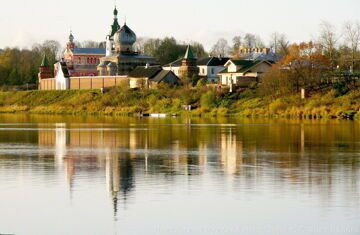|
Welcome!
St. Nicholas Monastery for Men The monastery is one of the oldest in Russian Orthodox Diocese of St. Petersburg, Russia
By car If you go from St. Petersburg by car, you should find the Federal high road М18 (Kola). Continue to follow М18 high road to the Volkhov river. Before the bridge on the Volkhov river turn to the right and follow by the A115 high road to the village of Staraya Ladoga. There are electric trains that go from St. Petersburg to Volkhov. They depart from Moskovsky station as well as Ladozhsky station every 2 hours. It takes 2.5 hours to get to Volkhov by train.
Many buildings of the Monastery are under construction now and we ask that you prayerfully consider helping us toward the complete restoration of the Monastery. God Bless you! |
About the MonasteryWe are glad to welcome you at the official website of our Monastery!
St. Nicholas Monastery is a male monastic community under the auspices of The Moscow Patriarchate. The buildings of the Monastery are located near the St. Nicholas Temple which was built in the 12th century, half a mile upstream along the Volkhov river near Staraya Ladoga Fortress. The terrain near the Monastery on the left bank of the Volkhov river is weird. There is a group of old tumuluses where old military burials of 8th to 10th centuries as well as of 13th century (the times of Saint Alexander Nevsky) were found. HistoryAccording to a legend, the Monastery was founded by Saint Alexander Nevsky after The Battle of the Neva in which the villagers of Staraya Ladoga took part. The Monastery chronicle states that it was founded ‘in memoriam of the lost Ladoga congeners’ who were companions in arms with Alexander. After the Battle they were brought to Staraya Ladoga and buried in a tumulus which was later called Pobedische (the Victory Tumulus). So the Monastery is considered as the monument of Russian military glory.
TemplesThe Monastery Cathedral, built in 10th -11th century, was sanctified in the name of the the most popular Saint in Russia – Saint Nicholas of Myra, the Wonderworker, who is the patron of sailors, fishermen and travelers.
Monastery TodayIn 1974 the buildings of the Monastery were declared monuments of federal significance. Restoration of the holy gates, the campanile, the fence and St. Nicholas Cathedral was made at that time. On December 26th 2002, by decision of Holy Synod of the Russian Orthodox Church, the Monastery opened its gates for ‘monastic life revival’ and became active. The Prior of the Monastery, father superior Varfolomey (Vladimir Chupov) was appointed. In the same year Metropolitan of St. Petersburg and Ladoga Vladimir brought the relics of St. Nicholas of Myra from the Italian city of Bari to the Monastery. At present there are not many monks living at the Monastery because the cell buildings are not restored yet. The main St. Nicholas Temple of the Monastery is not restored too.
We are glad to welcome pilgrims and tourists to visit the Monastery and share our joy about its restoration.
|
The Chernigov-Gethsemane Icon of the Mother of God
Commemorated on September 1/14
There is a copy of the Chernigov-Gethsemane Icon of the Mother of God in the Temple of Saint John Chrysostom in the monastery. Here is the story of the Icon. |







